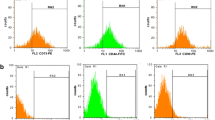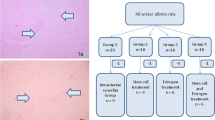Abstract
Asherman syndrome (AS) occurs due to fibrosis or uterine adhesions as a result of damage to the basal layer of the endometrium. The aim of this study is investigating the effects of adipose tissue-derived mesenchymal stem cell (ADMSC) application on the expression of vascular endothelial growth factor (VEGF), insulin-like growth factor (IGF-1), miRNA-98, miRNA199a in endometrial tissue in rats with AS. Study groups were designed as, control (C), Asherman syndrome (AS), AS + oral estrogen (ASO), AS + ADMSC (ASSC), AS + oral estrogen + ADMSC (ASSCO) with 7 samples in each group. Characterization and differentiation experiments were performed in ADMSC obtained. Two weeks after the development of the AS, ADMSC therapy was applied. BrdU (5-bromo-2′-deoxyuridine) labeling was performed to show the presence of ADMSC in the tissues. Rats were sacrificed after 8 weeks and bilateral uterine horn resection was performed. Tissues were fixed in formaldehyde. After routine tissue follow-up, sections were taken and evaluated with hematoxylin eosin staining. VEGF1 and IGF1 expressions were evaluated by immunohistochemical staining and western blot analysis. Expression changes of miR-98 and miR-199a were detected by RT-PCR. Our results showed that stem cells and estrogen giving together reduced inflammation and fibrosis in the endometrium. Immunohistochemistry and western blot results suggested that this effect was achieved especially through IGF-1. In our study, decreased miR-98 and miR-199a expressions were determined in Asherman syndrome. Furthermore, no changes of miRNA expressions were observed in treatment groups.








Similar content being viewed by others
Abbreviations
- AS:
-
Asherman syndrome
- ADMSC:
-
Adipose tissue-derived mesenchymal stem cell
- VEGF:
-
Vascular endothelial growth factor
- IGF-1:
-
Insulin-like growth factor
- BrdU:
-
5-Bromo-2′-deoxyuridine
- RT-PCR:
-
Real time polymerase chain reaction
- BM-MSC:
-
Bone marrow-mesenchymal stem cell
- miRNA:
-
MicroRNA
- PBS:
-
Phosphate-buffered saline
- HG-DMEM:
-
High glucose Dulbecco's modified Eagle's medium
- FBS:
-
Fetal bovine serum
- KÖGEM:
-
Kocaeli University stem cell and gene therapy research and application centre
- HCl:
-
Hydrocholric acid
- HRP-SA:
-
Horse radish peroxidase conjugate streptavidin
- H SCORE:
-
Histological Score
- GAPDH:
-
Glyceraldehyde 3-phosphate dehydrogenase
- HRT:
-
Hormone replacement therapy
- hAEC:
-
Human amniotic epithelial cell
References
Alawadhi F, Du H, Cakmak H, Taylor HS (2014) Bone marrow-derived stem cell (BMDSC) transplantation improves fertility in a murine model of Asherman’s syndrome. PLoS ONE 9(5):e96662
Gan L, Duan H, Xu Q, Tang YQ et al (2017) Human amniotic mesenchymal stromal cell transplantation improves endometrial regeneration in rodent models of intrauterine adhesions. Cytotherapy 19(5):603–616
Ding L, Li X, Sun H, Su J et al (2014) Transplantation of bone marrow mesenchymal stem cells on collagen scaffolds for the functional regeneration of injured rat uterus. Biomaterials 35(18):4888–4900
Choi JS, Ryu HA, Cheon SH, Kim SW (2019) Human adipose derived stem cells exhibit enhanced liver regeneration in acute liver ınjury by controlled releasing hepatocyte growth factor. Cell Physiol Biochem 52(4):935–950
Şahin B, Karagün B, Şaşmaz Aİ, Kılınç Y (2014) Mikro RNA and Kanser. Türk Klinik Biyokimya Derg 12(1):45–56
Saydam F, Değirmenci İ, Veysi H (2011) MikroRNA’lar ve kanser Güneş Dicle Tıp Dergisi. Dicle Med J 38(1):113–120
Bodur E, Demirpençe E (2010) Kodlanmayan RNA’lar ve Gen Susturumu. Hacettepe Tıp Dergisi 41:82–89
Chen K, Chen X, He J, Ding Y et al (2015) Mouse endometrium temporal and spatial expression mRNA and MicroRNA associated with embryo implantation. Reprod Sci 22(11):1399–1408
Xia HF, Jin X-H, Cao Z-F, Shi T, Ma X (2014) MiR-98 is involved in rat embryo implantation by targeting Bcl-xl. FEBS Lett 588:574–583
Xia HF, Cao J-L, Jin X-H, Ma X (2013) MiR199a is implicated in embryo implantation by regulating Grb10 in rat. Reproduction 147:91–99
Xia HF, Jin X-H, Cao Z-F, Hu Y, Ma X (2014) MicroRNA expression and regulation in the uterus during embryo implantation in rat. FEBS J 281:1872–1891
Gao L, Huang Z, Lin H, Tian Y, Li P, Lin S (2018) Bone marrow mesenchymal stem cells (BMSCs) restore functional endometrium in the rat model for severe Asherman syndrome. Reprod Sci 26:436–444
Liu F, Hu S, Yang H, Li Z et al (2019) Hyaluronic acid hydrogel ıntegrated with mesenchymal stem cell-secretome to treat endometrial ınjury in a rat model of Asherman's syndrome. Adv Healthc Mater 8(14):e1900411
Suh DY, Hunt TK, Spencer EM (1992) Insulin-like growth factor-I reverses the impairment of wound healing induced by corticosteroids in rats. Endocrinology 131(5):2399–2403
Giudice LA, Dsupin BA, Jin IH, Vu TH, Hoffman AR (1993) Differential expression of messenger ribonucleic acids encoding insulin-like growth factors and their receptors in human uterine endometrium and decidua. J Clin Endocrinol Metab 76(5):1115–1122
Rutanen EM (1998) Insulin-like growth factors in endometrial function. Gynecol Endocrinol 12(6):399–406
Risau W (1997) Mechanisms of angiogenesis. Nature 386(6626):671–674
Wei P, Chen XL, Song XX, Han CS, Liu YX (2004) VEGF, bFGF, and their receptors in the endometrium of rhesus monkey during menstrual cycle and early pregnancy. Mol Reprod Dev 68(4):456–462
Fan X, Krieg S, Kuo CJ, Wiegand SJ, Rabinovitch M, Druzin ML, Brenner RM, Giudice LC, Nayak NR (2008) VEGF blockade inhibits angiogenesis and reepithelialization of endometrium. FASEB J 22(10):3571–3580
Chen L, Qu J, Xiang C (2019) The multi-functional roles of menstrual blood-derived stem cells in regenerative medicine. Stem Cell Res Therapy 10:1
Li B, Zhang Q, Sun J, Lai D (2019) Human amniotic epithelial cells improve fertility in an intrauterine adhesion mouse model. Stem Cell Res Therapy 10(1):257
Wendler A, Keller D, Albrecht C, Peluso JJ et al (2011) Involvement of let-7/miR-98 microRNAs in the regulation of progesterone receptor membrane component 1 expression in ovarian cancer cells. Oncol Rep 25(1):273–279
Xiang Q, Tang H, Yu J, Yin J et al (2013) MicroRNA-98 sensitizes cisplatin-resistant human lung adenocarcinoma cells by up-regulation of HMGA2. Pharmazie 68(4):274–281
Yanaihara N, Caplen N, Bowman E, Seike M et al (2006) Unique microRNA molecular profiles in lung cancer diagnosis and prognosis. Cancer Cell 9:189–198
Li F, Li XJ, Qiao L, Shi F et al (2014) miR-98 suppresses melanoma metastasis through a negative feedback loop with its target gene IL-6. Exp Mol Med 46(10):116–125
Xia HF, Jin XH, Cao ZF, Shi T, Ma X (2013) MiR-98 is involved in rat embryo implantation by targeting Bcl-xl febslet. FEBS Lett 588(4):574–583
Panda H, Chuang TD, Luo X, Chegini N (2012) Endometrial miR-181a and miR-98 expression is altered during transition from normal into cancerous state and target PGR, PGRMC1, CYP19A1, DDX3X, and TIMP3. J Clin Endocrinol Metab 97(7):E1316–E1326
Ning H, Zhiheng C, Yifan P et al (2019) High expression of MiR-98 is a good prognostic factor in acute myeloid leukemia patients treated with chemotherapy alone. J Cancer 10(1):178–218
Shen Q, Cicinnati VR, Zhange X, Lacob S et al (2010) Role of microRNA-199a-5p and discoidin domain receptor 1 in human hepatocellular carcinoma invasion. Mol Cancer 9:227
He J, Jing Y, Li W, Qian X et al (2013) Roles and mechanism of miR-199a and miR-125b in tumor angiogenesis. PLoS ONE 8:e56647
Dai L, Lou W, Zhu J, Zhou X, Di W (2015) MiR-199a inhibits the angiogenic potential of endometrial stromal cells under hypoxia by targeting HIF-1α/VEGF pathway. Int J Clin Exp Pathol 8(5):4735–4744
Pencheva N, Tran H, Buss C, Huh D et al (2012) Convergent multi-miRNA targeting of ApoEdrives LRP1/LRP8-dependent melanoma metastasis and angiogenesis. Cell 151:1068–1082
Chan YC, Roy S, Huang Y, Khanna S, Sen CK (2012) The microRNA miR-199a-5p down-regulation switches on wound angiogenesis by derepressing the v-ets erythroblastosis virus E26 oncogene homolog 1-matrix metalloproteinase-1 pathway. J Biol Chem 287:41032–41043
Inyawilert W, Fu TY, Lin CT, Tang PC (2014) MicroRNA-199a mediates mucin 1 expression in mouse uterus during implantation. Reprod Fertil Dev 26(5):653–656
Williams KC, Renthal NE, Gerard RD, Mendelson CR (2013) The microRNA (miR)-199a/214 cluster mediates opposing effects of progesterone and estrogen on uterine contractility during pregnancy and labor. Mol Endocrinol 27(1):188
Acknowledgements
This study was supported by Pamukkale University Scientific Research Projects Coordination Unit through Project Numbers 2016BSP001.
Author information
Authors and Affiliations
Corresponding author
Ethics declarations
Conflict of interest
The authors have no conflicts of interest to disclose.
Ethical approval
Ethics committee approval was obtained from the ethics committee of Animal Experiments Ethics Committee of Pamukkale University (Denizli, Turkey) with the number PAU EK-2015/17. Ethical approval all applicable, national, international and/or institutional guidelines for the care and use of animals were followed. This article does not contain any studies with human participants performed by any of the authors.
Additional information
Publisher's Note
Springer Nature remains neutral with regard to jurisdictional claims in published maps and institutional affiliations.
Rights and permissions
About this article
Cite this article
Çil, N., Yaka, M., Ünal, M.S. et al. Adipose derived mesenchymal stem cell treatment in experimental asherman syndrome induced rats. Mol Biol Rep 47, 4541–4552 (2020). https://doi.org/10.1007/s11033-020-05505-4
Received:
Accepted:
Published:
Issue Date:
DOI: https://doi.org/10.1007/s11033-020-05505-4




